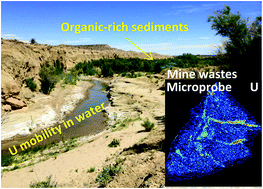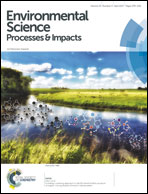Uranium mobility and accumulation along the Rio Paguate, Jackpile Mine in Laguna Pueblo, NM†
Abstract
The mobility and accumulation of uranium (U) along the Rio Paguate, adjacent to the Jackpile Mine, in Laguna Pueblo, New Mexico was investigated using aqueous chemistry, electron microprobe, X-ray diffraction and spectroscopy analyses. Given that it is not common to identify elevated concentrations of U in surface water sources, the Rio Paguate is a unique site that concerns the Laguna Pueblo community. This study aims to better understand the solid chemistry of abandoned mine waste sediments from the Jackpile Mine and identify key hydrogeological and geochemical processes that affect the fate of U along the Rio Paguate. Solid analyses using X-ray fluorescence determined that sediments located in the Jackpile Mine contain ranges of 320 to 9200 mg kg−1 U. The presence of coffinite, a U(IV)-bearing mineral, was identified by X-ray diffraction analyses in abandoned mine waste solids exposed to several decades of weathering and oxidation. The dissolution of these U-bearing minerals from abandoned mine wastes could contribute to U mobility during rain events. The U concentration in surface waters sampled closest to mine wastes are highest during the southwestern monsoon season. Samples collected from September 2014 to August 2016 showed higher U concentrations in surface water adjacent to the Jackpile Mine (35.3 to 772 μg L−1) compared with those at a wetland 4.5 kilometers downstream of the mine (5.77 to 110 μg L−1). Sediments co-located in the stream bed and bank along the reach between the mine and wetland had low U concentrations (range 1–5 mg kg−1) compared to concentrations in wetland sediments with higher organic matter (14–15%) and U concentrations (2–21 mg kg−1). Approximately 10% of the total U in wetland sediments was amenable to complexation with 1 mM sodium bicarbonate in batch experiments; a decrease of U concentration in solution was observed over time in these experiments likely due to re-association with sediments in the reactor. The findings from this study provide new insights about how hydrologic events may affect the reactivity of U present in mine waste solids exposed to surface oxidizing conditions, and the influence of organic-rich sediments on U accumulation in the Rio Paguate.



 Please wait while we load your content...
Please wait while we load your content...